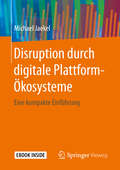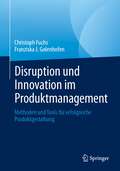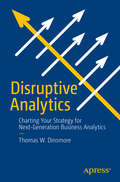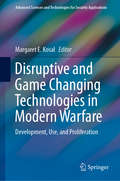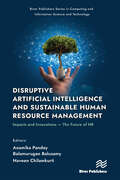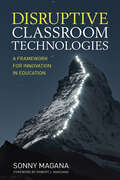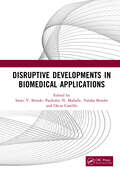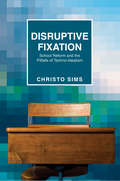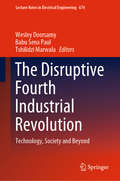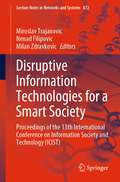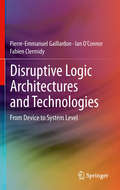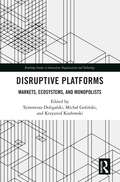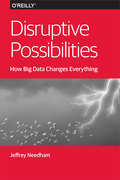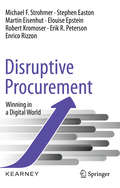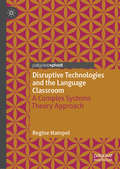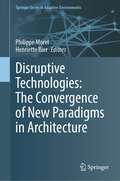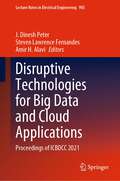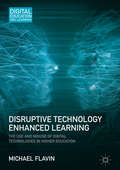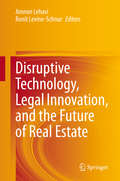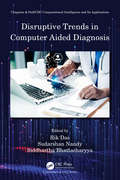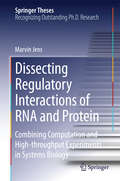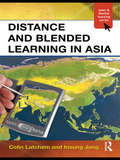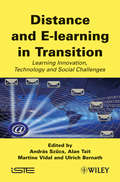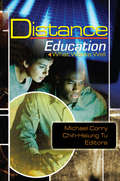- Table View
- List View
Disruption durch digitale Plattform-Ökosysteme: Eine kompakte Einführung
by Michael JaekelDisruption ist das Schlagwort einer Digitalmoderne, in der digitale Plattform-Ökosysteme eine neue Ökonomie erzeugen. Es expandiert eine Plattform-Ökonomie, die etablierte Unternehmen und Industrien in ihren Grundfesten erschüttert. Die Erschütterungen werden von dem Phänomen der Disruption ausgelöst. In Literatur und Praxis wird der Begriff der Disruption aber inflationär für nahezu alles herangezogen. Daher zielt das vorliegende kompakte Buch auf die kohärente Klärung des Begriffs der Disruption als ein Axiom der Digitalmoderne ab. Zudem erläutert der Autor die Expansionsdynamiken digitaler Plattform-Öko-Systeme durch Big Data-Management und Anwendungen der schwachen Künstlichen Intelligenz. Die Ausführungen zeigen die Relevanz der Disruptionstheorie praxisorientiert am Beispiel der digitalen Transformation eines großen Verlagshauses. Der Autor bietet mit seinem Werk Denkwerkzeuge und -anregungen, jedoch keinen schablonenhaften Ratgeber. Damit richtet sich das Buch an alle, die sich mit disruptiven Dynamiken der Digitalisierung kritisch auseinandersetzen und eigene Gedanken weiterentwickeln möchten.
Disruption und Innovation im Produktmanagement: Methoden und Tools für erfolgreiche Produktgestaltung
by Christoph Fuchs Franziska J. GolenhofenDieses Buch ist ein unverzichtbarer Leitfaden für jeden, der an der Konzeption und Entwicklung von Produkten beteiligt ist. Es beantwortet zwei grundlegende Fragen: Wie können Unternehmen einen Innovationsprozess und ein Umfeld gestalten, das für ein erfolgreiches Produktdesign förderlich ist? Und: Wie kann man ein Produkt retten, wenn das ursprüngliche Konzept die Markterwartung der Kunden nicht erfüllt?Die Autor*innen erläutern, wie Unternehmen Innovationsansätze und den Grundsatz „Form follows Function" in der Systemarchitektur vereinen. Sie zeigen Methoden wie Market Understanding, Design Thinking, Design to Value, Modularisierung und Agility auf, die in Zeiten von Disruption, Unsicherheit und Komplexität unentbehrlich geworden sind und in zahlreichen Branchen erprobt wurden. Mit vielen Erfahrungsberichten, Beispielen und Fallstudien sowie hilfreichen Tools zur praktischen Anwendung. "Auf der grundlegendsten Ebene bringt dieses Buch Ordnung ins Chaos. Es setzt unterschiedliche und hochrelevante Designansätze zu komplementären Lösungsansätzen für das Problem zusammen. Produktdesigner, Manager, Berater, Wissenschaftler und Studierende werden dieses wertvolle Buch sicher täglich zur Hand haben." Olivier L. de Weck, Ph.D. – MIT Professor für Luft- und Raumfahrttechnik und Engineering Systems, Chefredakteur Systems EngineeringDieses Buch stellt die Übersetzung einer englischsprachigen Originalausgabe dar. Die Übersetzung wurde mit Hilfe von künstlicher Intelligenz erstellt (maschinelle Übersetzung mit DeepL.com). Eine anschließende manuelle Überarbeitung erfolgte vor allem nach inhaltlichen Gesichtspunkten, so dass das Buch stilistisch von einer herkömmlichen Übersetzung abweicht.
Disruptive Analytics
by Thomas W. DinsmoreLearn all you need to know about seven key innovations disrupting business analytics today. These innovations—the open source business model, cloud analytics, the Hadoop ecosystem, Spark and in-memory analytics, streaming analytics, Deep Learning, and self-service analytics—are radically changing how businesses use data for competitive advantage. Taken together, they are disrupting the business analytics value chain, creating new opportunities.Enterprises who seize the opportunity will thrive and prosper, while others struggle and decline: disrupt or be disrupted. Disruptive Business Analytics provides strategies to profit from disruption. It shows you how to organize for insight, build and provision an open source stack, how to practice lean data warehousing, and how to assimilate disruptive innovations into an organization.Through a short history of business analytics and a detailed survey of products and services, analytics authority Thomas W. Dinsmore provides a practical explanation of the most compelling innovations available today.What You'll LearnDiscover how the open source business model works and how to make it work for youSee how cloud computing completely changes the economics of analyticsHarness the power of Hadoop and its ecosystemFind out why Apache Spark is everywhereDiscover the potential of streaming and real-time analyticsLearn what Deep Learning can do and why it mattersSee how self-service analytics can change the way organizations do businessWho This Book Is ForCorporate actors at all levels of responsibility for analytics: analysts, CIOs, CTOs, strategic decision makers, managers, systems architects, technical marketers, product developers, IT personnel, and consultants.
Disruptive and Game Changing Technologies in Modern Warfare: Development, Use, and Proliferation (Advanced Sciences and Technologies for Security Applications)
by Margaret E. KosalThis book explores and analyzes emerging innovations within today’s most cutting-edge science and technology (S&T) areas, which are cited as carrying the potential to revolutionize governmental structures, economies, and international security. Some have argued that such technologies will yield doomsday scenarios and that military applications of such technologies have even greater potential than nuclear weapons to radically change the balance of power. As the United States looks to the future – whether dominated by extremist groups co-opting advanced weapons in the world of globalized non-state actors or states engaged in persistent regional conflicts in areas of strategic interest – new adversaries and new science and technology will emerge. Choices made today that affect science and technology will impact how ably the US can and will respond. Chapters within the book look at the changing strategic environment in which security operations are planned and conducted; how these impact science and technology policy choices made today; and predictions of how science and technology may play a beneficial or deleterious role in the future. Some game changing technologies have received global attention, while others may be less well known; the new technologies discussed within this proposal, as well as future discoveries, may significantly alter military capabilities and may generate new threats against military and civilian sectors.
Disruptive Artificial Intelligence and Sustainable Human Resource Management: Impacts and Innovations -The Future of HR (River Publishers Series in Computing and Information Science and Technology)
by Anamika Pandey Balamurugan Balusamy Naveen ChilamkurtiIt is well-established that every organization is founded with a specific purpose and goals. Virtually all business organizations obtain measurements and metrics dealing with outcomes and results. However, what is reflected on the balance sheet does not necessarily show the actual worth of the organizations and ensure their survival and sustainability. Thus, the question arises, what exactly makes the organizations sustainable and thriving in an ever-changing environment? There are several examples of companies like Faber-Castell, Bank of Ireland, Chivas, DuPont and many more which have been able to sustain and survive over more than 200 years and still have a successful existence in the present era. Thus, it is important for the organization to pay equal attention to its three bottom lines, i.e., people, profit and planet for its sustainability, which not only meet the needs of the present generation but should have a futuristic approach as well. In the present era, organizations are adopting a new normal working dynamic and coping with the post-pandemic situations to sustain themselves in the business environment. Technology plays a significant role in this new working dynamic, and cutting-edge technologies like machine learning, artificial intelligence, blockchain,ChatGPT, Internet of Things, and much more effectively facilitate human functioning at work. The book aims to contribute to understanding and developing sustainable human resource management processes and practices aligned with recent technologies. It highlights the interconnection among the three bottom-line sustainable approaches for the growth and development of the organization. Topics discussed in this book include: • Disruptive Technologies and HR Sustainability • Convergence of Innovative Technologies, HR and Organizational Growth • Triple bottom-line Sustainability for HRM • Business-oriented Talent analytics and HR Sustainability • Role of Leadership in sustainable HRM practices.
Disruptive Classroom Technologies: A Framework for Innovation in Education
by Sonny MaganaTimely and powerful, this book offers a new framework to elevate instructional practices with technology and maximize student learning. The T3 Framework helps teachers categorize students’ learning as translational, transformational, or transcendent, sorting through the low-impact applications to reach high-impact usage of technologies. Teachers and leaders will find: Examples of technology use at the translational, transformational, and transcendent levels Activities, guides, and prompts for deeper learning that move technology use to higher levels of the T3 Framework Evaluative rubrics to self-assess current technology use, establish meaningful goals, and track progress towards those goals
Disruptive Classroom Technologies: A Framework for Innovation in Education
by Sonny MaganaTimely and powerful, this book offers a new framework to elevate instructional practices with technology and maximize student learning. The T3 Framework helps teachers categorize students’ learning as translational, transformational, or transcendent, sorting through the low-impact applications to reach high-impact usage of technologies. Teachers and leaders will find: Examples of technology use at the translational, transformational, and transcendent levels Activities, guides, and prompts for deeper learning that move technology use to higher levels of the T3 Framework Evaluative rubrics to self-assess current technology use, establish meaningful goals, and track progress towards those goals
Disruptive Developments in Biomedical Applications
by Swati V. Shinde Parikshit N. Mahalle Varsha Bendre Oscar CastilloThis book covers advancements and future challenges in biomedical application development using disruptive technologies like AI, IoT and signal processing. Book is divided into four main sections namely medical image processing using AI, IoT and biomedical devices, biomedical signal processing and electronic health records including advances in biomedical systems. It includes different case studies of biomedical applications using different AI algorithms related to diabetes, skin cancer, breast cancer, cervical cancer, osteoarthritis, and so forth. Features: Covers different technologies like AI, IOT and signal processing in the context of biomedical applications. Reviews medical image analysis, disease detection, and prediction. Comprehends the advantage of recent technologies for medical record keeping through electronics health records (EHRs). Presents state of art research in the field of biomedical engineering using various physiological signals. Explores different Bio Sensors used in Healthcare Applications using IOT. This book aims at Graduate students and researchers in artificial intelligence, medical imaging, biomedical engineering, and internet of things.
Disruptive Fixation: School Reform and the Pitfalls of Techno-Idealism
by Christo SimsIn New York City in 2009, a new kind of public school opened its doors to its inaugural class of middle schoolers. Conceived by a team of game designers and progressive educational reformers and backed by prominent philanthropic foundations, it promised to reinvent the classroom for the digital age. Ethnographer Christo Sims documented the life of the school from its planning stages to the graduation of its first eighth-grade class. Disruptive Fixation is his account of how this "school for digital kids," heralded as a model of tech-driven educational reform, reverted to a more conventional type of schooling with rote learning, an emphasis on discipline, and traditional hierarchies of authority. Troubling gender and racialized class divisions also emerged.Sims shows how the philanthropic possibilities of new media technologies are repeatedly idealized even though actual interventions routinely fall short of the desired outcomes—often dramatically so. He traces the complex processes by which idealistic tech-reform perennially takes root, unsettles the worlds into which it intervenes, and eventually stabilizes in ways that remake and extend many of the social predicaments reformers hope to fix. Sims offers a nuanced look at the roles that powerful elites, experts, the media, and the intended beneficiaries of reform—in this case, the students and their parents—play in perpetuating the cycle.Disruptive Fixation offers a timely examination of techno-philanthropism and the yearnings and dilemmas it seeks to address, revealing what failed interventions do manage to accomplish—and for whom.
The Disruptive Fourth Industrial Revolution: Technology, Society and Beyond (Lecture Notes in Electrical Engineering #674)
by Wesley Doorsamy Babu Sena Paul Tshilidzi MarwalaThe book explores technological advances in the fourth industrial revolution (4IR), which is based on a variety of technologies such as artificial intelligence, Internet of Things, machine learning, big data, additive printing, cloud computing, and virtual and augmented reality. Critically analyzing the impacts and effects of these disruptive technologies on various areas, including economics, society, business, government, labor, law, and environment, the book also provides a broad overview of 4IR, with a focus on technologies, to allow readers to gain a deeper understanding of the recent advances and future trajectories. It is intended for researchers, practitioners, policy-makers and industry leaders.
Disruptive Information Technologies for a Smart Society: Proceedings of the 13th International Conference on Information Society and Technology (ICIST) (Lecture Notes in Networks and Systems #872)
by Miroslav Trajanovic Nenad Filipovic Milan ZdravkovicThis book aims at meeting the challenge of getting along with today’s unprecedented rate of innovation supported by disruptive digital technologies, which changed the perception of the productivity and effectiveness and opened a gateway to more than ever dynamic advances in solving the important societal challenges. "Disruptive Information Technologies for a Smart Society" is the proceedings book of the 13th International conference for information society and technologies that brings together experts from various fields to discuss the latest advancements in software engineering, machine learning, digital water, and ICT for health and sport. The book and the conference serve as a platform for researchers of all career stages in technical sciences, especially Ph.D. students, practitioners, and industry experts in health care, energy, Fintech, AI, and other areas to share and learn on the cutting-edge technologies and stay at the forefront of these rapidly evolving fields.
Disruptive Logic Architectures and Technologies
by Fabien Clermidy Pierre-Emmanuel Gaillardon Ian O’connorThis book discusses the opportunities offered by disruptive technologies to overcome the economical and physical limits currently faced by the electronics industry. It provides a new methodology for the fast evaluation of an emerging technology from an architectural prospective and discusses the implications from simple circuits to complex architectures. Several technologies are discussed, ranging from 3-D integration of devices (Phase Change Memories, Monolithic 3-D, Vertical NanoWires-based transistors) to dense 2-D arrangements (Double-Gate Carbon Nanotubes, Sublithographic Nanowires, Lithographic Crossbar arrangements). Novel architectural organizations, as well as the associated tools, are presented in order to explore this freshly opened design space.
Disruptive Platforms: Markets, Ecosystems, and Monopolists (Routledge Studies in Innovation, Organizations and Technology)
by Tymoteusz Doligalski, Michał Goliński, and Krzysztof KozłowskiIt has taken platforms only twenty years to become digital economy hubs. They have changed markets, enterprises, and society. They have expedited communication, collaboration, and trade for consumers, winning their attention and collecting their data. In doing so, they have made processes, products, and industries obsolete, and disrupted the expectations and behaviours of market players. This raises the question, are digital platforms global innovators or disruptive monopolists? Are they a solution to problems of the past or emissaries of a problematic future? This book provides a multi-faceted approach to platforms and their profound impact on markets and ecosystems. Economic, managerial, social, and political aspects are analysed, and the differentiation of platforms and their disruptive potential is reviewed. The book also examines the mechanism of achieving a monopolistic position, including in the international supply chain, and the greater influence of platforms on political activity and contemporary democracy. With examples from Poland, USA, and China, the contributions offer an international evaluation of disruptive platforms across a multitude of industries. The edited collection, prepared by scholars from the SGH Warsaw School of Economics, will be valuable to researchers and academics across the fields of strategic management, marketing, innovations, international business, and the digital economy.
Disruptive Possibilities: How Big Data Changes Everything
by Jeffrey NeedhamIn Disruptive Possibilities: How Big Data Changes Everything i>, Jeff enlightens Fortune 500 enterprises about the Big Data ecosystem as they begin to channel their data from stranded silos into an accessible reservoir of possibility and discovery. Jeff explains where commercial supercomputing came from, where it is and its impact on the future of computing.
Disruptive Procurement: Winning in a Digital World
by Michael F. Strohmer Stephen Easton Martin Eisenhut Elouise Epstein Robert Kromoser Erik R. Peterson Enrico RizzonDisruptive Procurement is a radical new approach to creating value and innovation by challenging the status quo in the entire product and service line. It requires going far beyond conventional desktop procurement to understand the value the company brings to its customers as well as the value that suppliers bring to the company. By combining knowledge of these two dimensions, companies become far more flexible and they move closer to disrupting the environment in ways that create value. To move toward Disruptive Procurement, companies need a holistic view and a complete new set of capabilities for staff in marketing, sales, R&D, manufacturing, innovation, and, of course, procurement. This will only happen if procurement is fully backed by the Chief Executive Officer and companies embrace digital tools that will help make procurement slimmer and smarter.
Disruptive Technologies and the Language Classroom: A Complex Systems Theory Approach
by Regine HampelAlthough new technologies are embedded in students’ lives today, there is often an assumption that their use is transparent, inconsequential, or a distraction. This book combines complex systems theory with sociocultural theory and the multimodal theory of communication, providing an innovative theoretical framework to examine how communication and meaning-making in the language classroom have developed over time, how technology impacts on meaning-making, and what the implications are for learners, teachers, institutions and policy makers. Recent studies provide evidence for the disruptive effect of technology which has resulted in a phase shift that is reshaping language education by creating new interaction patterns, allowing for multimodal communication, and introducing real-world communication into the classroom. The book proposes ways of responding to this shift before concluding that the new technologies are radically transforming the way we learn. It is likely to appeal to a range of readers, including students, academics, teachers and policy-makers.
Disruptive Technologies: The Convergence of New Paradigms in Architecture (Springer Series in Adaptive Environments)
by Philippe Morel Henriette BierThrough a series of highly speculative contributions by both leading and highly acclaimed practitioners and theorists, this book gives a new comprehensive overview of architectures’ most recent practical and theoretical developments. While a few chapters are mostly dedicated to a historical analysis of how we got to experience a new technological reality in architecture and beyond, all chapters including the most forward looking, have in common their rigorous understanding of history as a pool of radical experiments, whether one speaks of the history of architecture, or of sociology, technology, and science. Disruptive Technologies: The Convergence of New Paradigms in Architecture is required reading for anybody student, practitioner, and educator who wants to do serious research in architecture and all disciplines dealing with the shaping of our environment, beyond the important but restricted domain of computational architectural design.Additional multimedia content via app: download the SN More Media app for free, scan a link with play button and access to the Additional Contents directly on your smartphone or tablet.
Disruptive Technologies for Big Data and Cloud Applications: Proceedings of ICBDCC 2021 (Lecture Notes in Electrical Engineering #905)
by J. Dinesh Peter Steven Lawrence Fernandes Amir H. AlaviThis book provides a written record of the synergy that already exists among the research communities and represents a solid framework in the advancement of big data and cloud computing disciplines from which new interaction will result in the future. This book is a compendium of the International Conference on Big Data and Cloud Computing (ICBDCC 2021). It includes recent advances in big data analytics, cloud computing, the Internet of nano things, cloud security, data analytics in the cloud, smart cities and grids, etc. This book primarily focuses on the application of knowledge that promotes ideas for solving the problems of society through cutting-edge technologies. The articles featured in this book provide novel ideas that contribute to the growth of world-class research and development. The contents of this book are of interest to researchers and professionals alike.
Disruptive Technology Enhanced Learning
by Michael FlavinThis book is about how technologies are used in practice to support learning and teaching in higher education. Despite digitization and e-learning becoming ever-increasingly popular in university teaching settings, this book convincingly argues instead in favour of simple and convenient technologies, thus disrupting traditional patterns of learning, teaching and assessment. Michael Flavin uses Disruptive Innovation theory, Activity Theory and the Community of Practice theory as lenses through which to examine technology enhanced learning. This book will be of great interest to all academics with teaching responsibilities, as it illuminates how technologies are used in practice, and is also highly relevant to postgraduate students and researchers in education and technology enhanced learning. It will be especially valuable to leaders and policy-makers in higher education, as it provides insights to inform decision-making on technology enhanced learning at both an institutional and sectoral level.
Disruptive Technology, Legal Innovation, and the Future of Real Estate
by Amnon Lehavi Ronit Levine-SchnurThis book addresses challenges that new technologies and the big data revolution pose to existing regulatory and legal frameworks. The volume discusses issues such as blockchain and its implications for property transactions and taxes, three (or four) dimensional title registration, land use and urban planning in the age of big data, and the future of property rights in light of these changes. The book brings together an interdisciplinary collection of chapters that revolve around the potential influence of disruptive technologies on existing legal norms and the future development of real estate markets. The book is divided into five parts. Part I presents a survey of the current available research on blockchain and real estate. Part II provides a background on property law for the volume, grounding it in fundamental theory. Part III discusses the changing landscapes of property rights while Part IV debates the potential effects of blockchain on land registration. Finally the book concludes with Part V, which is devoted to new technological applications relevant to real estate. Providing an interdisciplinary perspective on emerging technologies that have the potential to disrupt the real estate industry and the regulation of it, this book will appeal to a broad audience, consisting of scholars, policy-makers, practitioners, and students, interested in real estate, law, economics, blockchain, and technology policy.
Disruptive Trends in Computer Aided Diagnosis (Chapman & Hall/CRC Computational Intelligence and Its Applications)
by Rik DasDisruptive Trends in Computer Aided Diagnosis collates novel techniques and methodologies in the domain of content based image classification and deep learning/machine learning techniques to design efficient computer aided diagnosis architecture. It is aimed to highlight new challenges and probable solutions in the domain of computer aided diagnosis to leverage balancing of sustainable ecology. The volume focuses on designing efficient algorithms for proposing CAD systems to mitigate the challenges of critical illnesses at an early stage. State-of-the-art novel methods are explored for envisaging automated diagnosis systems thereby overriding the limitations due to lack of training data, sample annotation, region of interest identification, proper segmentation and so on. The assorted techniques addresses the challenges encountered in existing systems thereby facilitating accurate patient healthcare and diagnosis. Features: An integrated interdisciplinary approach to address complex computer aided diagnosis problems and limitations. Elucidates a rich summary of the state-of-the-art tools and techniques related to automated detection and diagnosis of life threatening diseases including pandemics. Machine learning and deep learning methodologies on evolving accurate and precise early detection and medical diagnosis systems. Information presented in an accessible way for students, researchers and medical practitioners. The volume would come to the benefit of both post-graduate students and aspiring researchers in the field of medical informatics, computer science and electronics and communication engineering. In addition, the volume is also intended to serve as a guiding factor for the medical practitioners and radiologists in accurate diagnosis of diseases.
Dissecting Regulatory Interactions of RNA and Protein
by Marvin JensThe work described in this book is an excellent example of interdisciplinary research in systems biology. It shows how concepts and approaches from the field of physics can be efficiently used to answer biological questions and reports on a novel methodology involving creative computer-based analyses of high-throughput biological data. Many of the findings described in the book, which are the result of collaborations between the author (a theoretical scientist) and experimental biologists and between different laboratories, have been published in high-quality peer-reviewed journals such as Molecular Cell and Nature. However, while those publications address different aspects of post-transcriptional gene regulation, this book provides readers with a complete, coherent and logical view of the research project as a whole. The introduction presents post-transcriptional gene regulation from a distinct angle, highlighting aspects of information theory and evolution and laying the groundwork for the questions addressed in the subsequent chapters, which concern the regulation of the transcriptome as the primary functional carrier of active genetic information.
Distance and Blended Learning in Asia (Open and Flexible Learning Series)
by Colin Latchem Insung JungDistance and Blended Learning in Asia is a unique and comprehensive overview of open, distance learning (ODL) and information and communication technology (ICT) in Asian education and training. Broad in coverage, this book critically examines ODL and ICT experiences from Japan to Turkey and from Sri Lanka to Mongolia – drawing conclusions from the successes and failures, and recommending ways in which planning, management and practice may be developed for the world’s largest concentration of adult open and distance learners. This pioneering book draws on Asian theory, research and practice to identify the strengths, weaknesses and challenges in all sectors of Asian education and training. It critically and insightfully discusses the ideas, skills and practices that are necessary to advance knowledge in leadership and management, professional development, innovation and quality assurance and research and diffusion. Distance and Blended Learning in Asia provides an insightful, informative and critical review of ODL / ICT developments in schools, open schooling, colleges, universities, workplace training, professional development and non-formal adult and community education. The book is an invaluable reference for ODL / ICT professionals, educators and students anywhere in the world, and is essential reading for all of those involved in ODL / ICT in Asia.
Distance and E-learning in Transition: Learning Innovation, Technology and Social Challenges
by András Szücs Alan Tait Martine Vidal Ulrich BernathThe rushed development of information and communication technologies and their impact on the world of learning in the last decade have profoundly changed the paradigms, scenarios and values at all levels of education. The professionalization of tools and practices, in addition to the consolidation of academic and practical knowledge, has been a major continuing issue throughout these years. The annual conferences of the largest European professional community in distance and e-learning have been setting the landmarks in this process. The selection from this unique knowledge pool demonstrates the deepening and consolidation of knowledge and experience. This book presents the developments in the field of open, distance and e-learning, through new technologies, methodologies and tools, which have profoundly changed the paradigms, scenarios and values at all levels of education over the last decade.
Distance Education: What Works Well
by Michael CorryDon&’t start from scratch! Learn what works-and what doesn&’t-in providing education to off-campus students! This unique compilation presents practical advice on how to set up distance learning programs that effectively serve the needs of students who don&’t have access to the campus. The book examines issues surrounding development, implementation, teacher training, time management, and other important aspects of distance education. Distance Education: What Works Well brings you lessons garnered from real-life experiences at several institutions to help you explore the pros and cons of distance education-and what it takes to implement a distance program that really works. In the first half of Distance Education: What Works Well you&’ll examine: the development of a digital high school-from the early stages through "rookie camp" experiences practical recommendations on how to design successful online high school programs what has worked well-and what has not-in terms of distance education in the rural K-12 environment the successful and not-so-successful aspects of an innovative distance education project that encourages collaboration between high schools and middle schools The second half of this informative book presents practical advice to help you set up distance learning programs that make the most of available technology. You&’ll learn: how to train faculty to effectively use distance education techniques the importance of student-teacher and student-student interaction in a distance education setting-and how to build active online communities that keep students and faculty in touch the roles and functions of moderators in online education-and the skills they need to be effective six effective tactics designed to optimize online time how to decide whether distance education is the right choice for you
